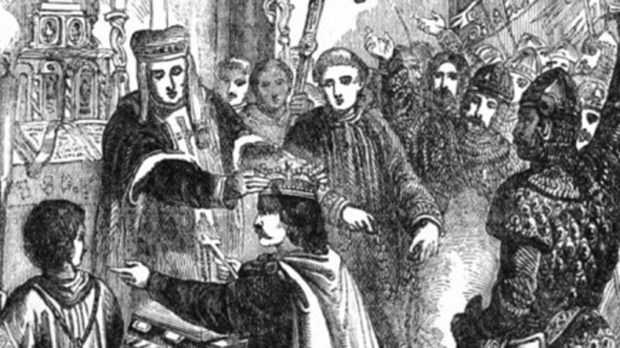Christmas is a day for going to church and giving thanks for the Incarnation. It’s a good opportunity for many people to spend time with family.
In history, Christmas has also been a good day to be crowned king or emperor.
There were at least three Christmas-day crownings of royalty in medieval Europe: Charlemagne in 800, Edmund in 855, and William the Conqueror in 1066.
For these three, perhaps it was the Christmas gift of a lifetime. Some of their subjects might have felt that way too.
Charlemagne was King of the Franks when he was crowned Holy Roman Emperor in the city of Rome. Becky Lawton explains on the Medieval Blog of the British Library that in the Christian West, Imperial authority had ceased to be acknowledged after the fall of the last Emperor of the Western Roman Empire in AD 476.
“By the end of the 8th century, Charlemagne’s military success had left in him control of a large part of medieval Europe and he had acquired a special relationship with the Pope,” Lawton writes. “By crowning Charlemagne as the first Holy Roman Emperor, Pope Leo III was acknowledging Charlemagne’s secular authority and his role as defender of the Christian faith throughout Western Christendom.”
About half a century later, a man named Edmund was crowned king of East Anglia on Christmas Day. He reigned from 855 until his death in 869.
“Very little is known about Edmund’s early life, as no contemporary written records survive from his reign,” Lawton tells us. “The first-known record focuses more on the circumstances of Edmund’s death than his achievements in life. The ‘Anglo-Saxon Chronicle’ described how Edmund was killed by the Great Heathen Army of Danes which had recently attacked other parts of Anglo-Saxon England. This is the same Great Heathen Army which was fought off by Alfred the Great of Wessex over the next decade.”
Lawton continues:
According to tradition, Edmund died during battle with the Danes after he refused their demands to renounce his Christian faith. This refusal transformed Edmund into a martyr. Over the following two centuries, a popular cult developed around his memory and was centred on the church where his remains were buried. The town which grew around this church was so associated with the cult of St. Edmund that it took on his name, becoming the modern-day Bury St. Edmunds in Suffolk.
Finally, on Christmas Day in 1066, William the Conqueror, was crowned King of England in Westminster Abbey. This event marked the end of Anglo-Saxon rule in England and the beginning of the Norman dynasty.
“It is extremely likely that these kings, or the people who wrote their legends, consciously chose to be crowned on Christmas Day,” Lawton concludes. “Those who celebrated their coronations on 25 December would also be celebrating the birth of Christ, the savior and King of Kings. This would have added a sense of Divine favor to their rule, and secured their claim to that particular title. The sacred significance of this would not have been lost on the audience of these ceremonies, those who recorded them, and those who read about them throughout history.”

